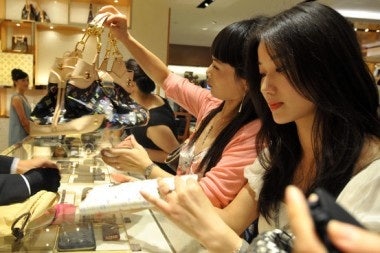Relatively Young Age Of China's Core Luxury Consumer Class Presents New Opportunities, Complexities For Luxury Brands#

China's luxury market is clearly an important and exciting place to be right now, but beyond the sales figures -- which are, obviously, impressive, showing that China leapfrogged past the US over the last year to become the world's second-largest luxury market -- it becomes clear that quantitative and qualitative considerations paint very different pictures of the current state of China's luxury industry. As we've written before, one of the issues with luxury figures in China is that these figures don't reflect much about demographics, geography, income levels or buying trends. They're just numbers.
Much like how China is the world's top beer market in terms of consumption volume, yet most Chinese drink only a fraction of what most Germans or Americans do in a year, a lot of China's quantitative luxury figures simply come down to the country's massive population and not to a huge surge in interest among the vast majority of the populace. So, it is probably not inaccurate to say that luxury brand marketers and brand managers aren't looking only at the raw figures, but are probably looking even more closely at the qualitative breakdown of the emerging Chinese luxury consumer.
As many articles recently have noted, China's luxury industry will probably be driven not by the middle-aged urban super-rich but instead by the country's fast-growing middle class, which is, generally, comprised of similarly urban, educated, 20- and 30-something office workers. Unlike their parents, this group of individuals -- broadly, but not completely, female -- has no compunction about spending most of their paycheck on conspicuous luxury products they really can't afford. Basically, they're a luxury exec's dream consumer: relatively loyal and easy to reach.
However, "easy to reach" doesn't always mean sales will be easy. China is a huge country with a massive population and staggering geographic diversity, and as a New York Times article today notes, complexities like generation gaps, geography, and cultural buying habits color the luxury trade throughout Greater China, leading companies like Zegna to diversify and localize their product offerings to appeal to their core consumer market -- which happens to be quite a bit younger in the Greater China region than in other established markets:
The average age of someone with 100 million yuan, or about $15 million, is 43. The approximately 825,000 Chinese with personal wealth of 10 million yuan are on average as young as 39, according to Hurun’s data — again, about 15 years younger than their counterparts in America or Europe.
“Much of this wealth has only been created since the 1980s — in other words, a solid generation later than in Hong Kong or Taiwan. You’d have to look back to the late nineteenth century in the United States or to the industrial revolution in Britain, to find anything comparable to the wave of entrepreneurs who are now starting up in China,” Mr. Hoogewerf said.
“Many luxury brands are having quite a bit of trouble with that,” he added. “A lot of Western brands are trying to apply the same model in China as they have back home, and are thus potentially targeting too old a group, when really they need to be more youthful and dynamic to attract these sorts of people.”
What is important about these figures is not only that the core luxury buyer in China is in his or her mid- to late-30s, but that the growth of this demographic has come in concert with the growth of the even younger, less wealthy but possibly more materialistic 20-somethings -- China's so-called "Me Generation." A TIME article last year drew a somewhat negative portrait of this generation, mainly because it only focused on a tiny sliver of ultra-pampered Beijingers, but the article's portrayal of China's "little emperors" -- children born after the institution of the one-child policy in the late 1970s -- looking to differentiate themselves in a highly competitive society through fashion and conspicuous consumption is valuable reading for anyone curious about how China's 20-somethings differ from the 30+ crowd. From the TIME article:
China's Me generation also has to prove adept at surfing a culture that's changing at a dizzying speed. While the rise of the Chinese economy is not unexpected, it's happening faster than anyone would have predicted. According to a Credit Suisse study, income among 20-to-29-year-olds grew 34% in the past three years, with a third of the same age group using credit cards—a concept largely foreign to previous generations. And yet the urban dwellers in this demographic don't seem the least bit disoriented by the booming capitalist-within-communist system—a fact that's not lost on European luxury retailers.
"Because China went through a recent dark age, because their mothers didn't have things, this generation is learning afresh," says Fendi ceo Michael Burke, who last fall branded the Great Wall with Fendi's double-F logo and held its first-ever fashion show there, setting the stage for more brand expansion. "They don't have a generation before them to refer to style-wise, so they are daring with the choices they make."
Since most members of this group, unlike the super-rich, is generally unable to travel overseas or cross-border for luxury-tax-free shopping sprees, they're most often reached out to in their home markets in the form of digital and print advertising and mall events. However, just because this group loves shopping for luxury goods doesn't mean they're low-hanging fruit for luxury brands. The rise of e-commerce in China has the potential to stall the continued growth of luxury brands in this lucrative but heterogeneous and ever-changing market -- and although the privileged Beijing girls profiled in the TIME article make for good print, they don't reflect the reality for the overwhelming majority of young luxury fans. All important things to keep in mind when trying to unravel the complex and very unique Chinese luxury market.